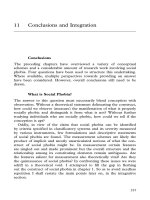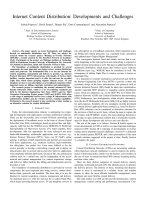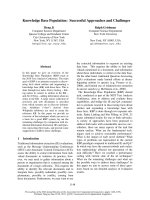Conclusions and Challenges
Bạn đang xem bản rút gọn của tài liệu. Xem và tải ngay bản đầy đủ của tài liệu tại đây (64.55 KB, 10 trang )
9
CONCLUSIONS AND CHALLENGES1
The technologies and standards required to implement VoIP service are cur-
rently well established and mature. Many equipment manufacturers are pres-
ently marketing interoperable products—such as IP phones, call servers or
managers, MGWs and SGs, and so on—to realize and manage the VoIP ser-
vice. Advances in digital signal processing and networking software, hardware,
and protocol technologies—as discussed in Chapters 2 and 3—have stimulated
the development of plug-and-talk-based IP phones. These phones can support
VoIP service over IP-based networks equipped with a call controller (CC) and
MGW. As discussed in Chapter 6, IP phones can automatically register them-
selves to a DNS/ENUM server once they are connected to an IP-based net-
work. Furthermore, these phones can derive electric power from the highly
reliable Ethernet switches over those wires of the Ethernet cable (a category
5 cable) that are not being used for data services. The software and hardware
configurations needed to deliver the subscribed services to the IP phones can
be managed—that is, upgraded, added, or deleted—by the subscribers them-
selves, and the required configurations can be downloaded over the Web by
the customers. Because of the openness and flexibility of IP-based call control
and signaling, many new and advanced add-on services can be developed,
integrated, and marketed very quickly and cost-e¤ectively. VoIP service can
be implemented either in a standalone fashion or as a complement to existing
PSTN-based telephone calling service.
When VoIP service is implemented in a standalone fashion, the following
127
1 The ideas and viewpoints presented here belong solely to Bhumip Khasnabish, Massachusetts,
USA.
elements are needed: IP phones, various computer servers for DNS/ENUM,
call control and signaling, hosting of applications and features, Ethernet
switches, IP-based edge and core routers, wiring infrastructures that are com-
monly used in LANs with an option to deliver electric power to the phones
from the switches, and so on.
In order to maintain the interoperability of the standalone VoIP network
with the well-established and century-old PSTN endpoints or terminals (i.e.,
POTS phones), a number of server and GW devices are necessary. These
devices include (a) IP-PSTN MGWs to support interworking with PSTN
transmission infrastructures (such as TDM links and trunks), (b) an SS7 SG
to interact with PSTN signaling and call control infrastructures, (c) service and
feature extraction and insertion servers and/or GWs for delivering the caller’s
name and number, voice message, and so on to an IP phone from a PSTN-
hosted feature server and voice mail box, respectively, and (d) GWs and/or
servers to support interactions with PSTN billing, operations, and management
systems.
Most enterprise networks have IP-based networking infrastructure already
in place for intracompany distributed computing and communications. These
networks are ideal candidates for experimenting with the introduction of
VoIP and other related services. Some medium-sized and large enterprises are
already experimenting with or have limited deployment of VoIP service, and
they are using many of the methods and architectures discussed in Chapters 6
and 8.
In public networks, VoIP service is now being introduced for national
long-distance (LD) and international telephone calling services, as discussed in
Chapters 7 and 8. Traditionally, these services are o¤ered by using the existing
CLASS-4 (and lower) type PSTN switches and SONET rings. These PSTN
switches are currently being replaced or augmented by IP-based multiservice
switches and routers that can support both voice and data communications.
The SONET rings are being replaced or augmented by IP-based mesh networks
of core (gigabit or terabit speed) routers, and these routers can support IP over
SONET (packet over SONET) or IP directly over fiber (e.g., gigabit Ethernet
for trunking applications) channels [1].
For residential telephone services, CLASS-5 switch replacement may not
occur in the foreseeable future. This is due to the fact that existing assets for
CLASS-5 switching and the twisted-pair copper wire–based local access net-
work have not yet fully depreciated even in the developed countries. Conse-
quently, service providers are delivering VoIP service to residential customers
using DSL lines, CATV networks’ channels, wireless local loop (WLL) chan-
nels, and so on, as discussed in Chapter 7.
Based on our experiences and experiments (as discussed in Chapters 4 and 5
and the appendixes), we present a set of guidelines for rolling out VoIP services
using any operational IP network. This is followed by a discussion of the most
challenging future research topics on the implementation of VoIP service.
128
CONCLUSIONS AND CHALLENGES
GUIDELINES FOR IMPLEMENTING VoIP
As mentioned throughout this book, the openness, flexibility, and widespread
availability of the IP-based network and services are fueling the unification of
distributed computing and communications (datacom and telecom) infrastruc-
tures, and their management and operations [2]. These promote consolidation
of the network element procurement and maintenance processes, resulting in a
significant reduction in overhead for networks and services.
However, in order to achieve cost-e¤ective (i.e., profitable) implementation
of the VoIP service, one must carefully select the following:
a. An open and scalable architecture framework for both networking and
enhancing the VoIP service;
b. Easily configurable standard interfaces and simple protocols for inter-
actions and interconnects among the various networking, service hosting,
and user-domain elements. This should be followed by the design of
access and transport networks and a plan to upgrade the existing oper-
ations support system; and
c. Mechanisms to guarantee—that is, assign or allocate, monitor, and
maintain—user authentication, secure transmission, and ETE QoS that
are at least as good as those supported by the PSTN.
As discussed in Chapter 1, the multiplane architecture framework proposed
by the MSF (as shown in Fig. 1-9 of Chapter 1) can be utilized for separating
the call control, media adaptation, and application hosting functions. This
architecture also helps achieve the required level of openness (of the inter-
connections) and granularity (of the elements), that makes it highly scalable.
IETF, ISC, and Cable Labs (www.cablelabs.com/projects/) have proposed
similar architecture frameworks. Once an architecture framework is selected, a
multiphase service rollout plan can be designed for a graceful transition of the
existing network infrastructures to deliver telephony and data services over an
IP-based, unified communication system.
For IP phones, although H.323, MGCP, and SIP (these protocols are dis-
cussed in Chapter 3) based phones are available, the SIP (IETF’s RFC 3261)
phones are gaining significantly more acceptance in the user community. This
can be attributed to the fact that SIP exploits a simple request/response pro-
tocol, such as the clear-text based instructions and headers like those in the
hypertext transfer protocol (HTTP), and many other Internet-based methods
and protocols (DNS, MIME, URL, SMTP, etc.) for setting up a real-time
telephone conversation session. These features also enable server-based
deployment and low-overhead invocation of many popular add-on services by
the SIP phones (clients). These services include Web-based click-to-call, unified
messaging, instant messaging and conferencing, on-line transactions (buying/
selling), and so on.
GUIDELINES FOR IMPLEMENTING VoIP
129
SIP-based VoIP service can be introduced in any operational IP network of
an enterprise by deploying the SIP server-based VoIP call controller (CC), call
manager, or call server. The SIP server contains an SIP registrar, a proxy, and
a redirect server, and the SIP phone contains the user agent—both client and
server. In addition to the basic call features (see, e.g., Table 6-2 in Chapter 6),
the VoIP CC hosts the basic call processing functions and maintains the call
states. Within the enterprise, a call between two SIP phones can now be estab-
lished under the control of one or more VoIP CCs of the enterprise network, as
illustrated in Chapters 3 and 6. In its simplest form, the VoIP CC may be
equipped with (a) a VoIP GW (a line card) with T1 interfaces for connectivity
with the PSTN network, for example, and (b) a line card to support the SMDI
interface over analog lines for integration with the existing voice mail system,
for example. Alternatively, (a) a line card–based VoIP GW can be introduced
in the existing (circuit-switch-based) PBX chassis with its Ethernet ports sup-
porting connectivity to a corporate LAN, and (b) an adjacent voice mail GW
device can be utilized for integration with an existing voice mail system over
the SDMI interface. To support unified messaging in such an environment,
additional servers—which support open APIs such as TAPI and JTAPI and
VoiceXML for IVR scripting—can be introduced. XML-based scripting can be
utilized for managing user profiles and the system configuration over the Web
[3].
As illustrated in Chapter 7, for residential customers the IP telephony service
can be delivered over DSL modem, cable modem (CM), and WLL receiver–
based network connections. Service providers need to be equipped with VoIP
call servers to perform call control and signaling for the VoIP calls originating
from the SIP phones—attached to the DSL modem, CM, or WLL receiver—
on customers’ premises. If telephone calls from SIP phones are destined for
PSTN or POTS phones, network elements such as the SS7 SG and the IP-
PSTN media gateway controller (MGC) will be directly involved in setting up
the connection for the call. The IP-PSTN MGW will provide all of the required
adaptation of the voice signal (or media) from the PSTN or TDM network to
the IP network. These are discussed in detail in Chapters 7 and 8 for various
network evolution scenarios. As discussed in Chapter 3, MGCP or the H.248/
Megaco protocol can be utilized to control the IP-PSTN MGW from the
MGC, and the MGC software can reside either in the VoIP call server or in an
adjacent computer server.
In order to support continuous availability of the service from the VoIP
call server, it may be necessary to provide battery-based backup of the electric
power supply. It may also be necessary to provide one-for-one redundancy
of the VoIP call server and the associated MGC. For the MGWs, applications,
and feature servers, cluster-based interconnections can be utilized to implement
a scalable solution cost-e¤ectively.
The IP network that is interconnecting these clusters, the VoIP CC, and the
access and delivery networks (LANs) must be multiconnected and properly
engineered so that it meets or exceeds the ETE QoS requirements for the VoIP
130
CONCLUSIONS AND CHALLENGES
service. In addition to the reliability and availability requirements, network
requirements for delay jitter, packet loss, and network delay limits—as dis-
cussed in Chapter 4—must be satisfied to deliver acceptable voice quality over
a VoIP session. As discussed in Appendixes A, B, and C, a number of VoIP
related experiments have been conducted using the testbed described in Chap-
ter 5. The results reveal that network impairments such as packet loss and
delay jitter significantly a¤ect the transmission of both voice and DTMF sig-
nals. Network delay—up to a certain limit—seems to have a less severe impact
on voice and DTMF transmission. DTMF transmission does not seem to be
strongly a¤ected by network delay. However, excessive delay jitter, packet
loss, and network delay sometimes cause call establishment attempts to fail
repeatedly.
When a call setup request arrives at the VoIP call server, it should be hon-
ored only when su‰cient ETE resources are available. These resources include
bandwidth, bu¤ers, and processing capacity for setting up and maintaining the
RTP session for the duration of the VoIP session.
As far as layer-1 (the physical layer of Fig. 2-10 in Chapter 2) is concerned,
two or more di¤erent physical links can be maintained from the Ethernet
switch (to which a SIP phone may be attached), for example, to the VoIP call
server. This strategy ensures that the call setup request will reach the VoIP call
server even when the primary physical connection fails.
In layer-2, the priority bits (a 3 bit field), as standardized by the IEEE
802.1p group, and the virtual LAN TAG bytes (a 4 byte field), as standardized
by the IEEE 802.1Q group, can be utilized to mark the tra‰c that is carrying
voice signal. These fields can define an appropriate class of service for the voice
packets and the user priority (virtual LAN tagging) in the media access control
(MAC) sublayer of the link layer (see, e.g., Fig. 2-10). In IEEE 802.1p, eight
di¤erent tra‰c prioritization levels are defined at the MAC framing sublayer,
and it uses a filtering mechanism to retain the multicast tra‰c within layer-2-
switched networks. The IEEE 802.1Q standard defines a format for tagging the
frames. Although the virtual LANs are server-port based, the services can be
extended to the desktop via tagging on trunk lines in LAN switches and rou-
ters. The IEEE 802.1p standard–based setting of the priority bits works very
well with the IEEE 802.1Q specifications for virtual LAN tagging. These fea-
tures can be exploited to achieve prioritized routing of the voice packets in any
Enterprise or private IP network. Most currently available LAN switches sup-
port implementation of the IEEE 802.1p and IEEE 802.Q standards. Further
details on the activities of IEEE 802 work and study groups can be found at
their websites (www.ieee802.org/dots.html, 2001).
In the network layer (layer-3 of Fig. 2-10), the type of service (TOS, an
8 bit field, as shown in Figs. 2-3 and 2-6) byte in IPv4 and IPv6 headers can
be utilized for setting the Di¤Serv code point (DSCP) at the edge of the IP
network. This enables classification of the packets into a small number of
aggregated flows or classes. Consequently, at each Di¤Serv router, the VoIP-
based telephone conversation related packets could be routed by using the
GUIDELINES FOR IMPLEMENTING VoIP
131









